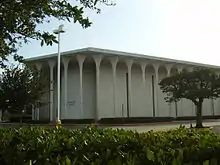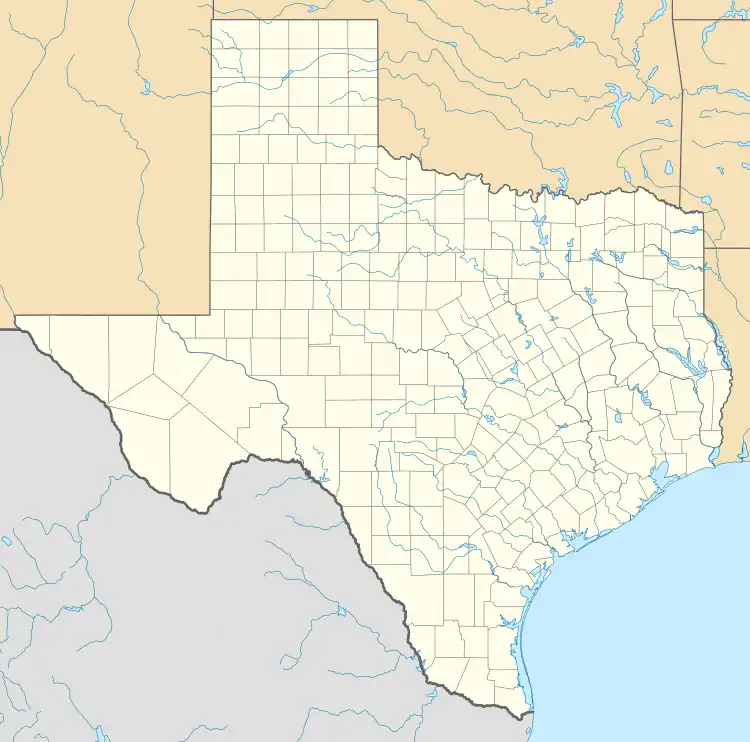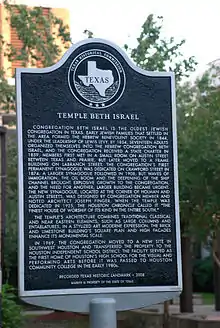Congregation Beth Israel (Houston)
Congregation Beth Israel of Houston, the oldest Jewish congregation in Texas, was founded in Houston in 1854. It operates the Shlenker School.
| Congregation Beth Israel | |
|---|---|
 | |
| Location | |
| Location | 5600 N. Braeswood Blvd. Houston, Texas 77096 |
History
Temple Beth Israel | |
 Temple Beth Israel building, 1925–1967 | |
 Location in Texas  Congregation Beth Israel (Houston) (the United States) | |
| Location | 3517 Austin St., Midtown Houston, Texas |
|---|---|
| Coordinates | 29°44′14″N 95°22′30″W |
| Built | 1924 |
| Architect | Finger, Joseph |
| Architectural style | Modern |
| NRHP reference No. | 84001826[1] |
| RTHL No. | 14339 |
| Significant dates | |
| Added to NRHP | March 1, 1984 |
| Designated RTHL | 1974 |
The congregation was founded in 1854 as an Orthodox Jewish kehilla and legally chartered in 1859.[2] The Orthodox Beth Israel Congregation in Houston opened in a former house that had been converted to a synagogue.[3] In 1874 the congregation voted to change their affiliation to Reform Judaism, sparking the foundation of Congregation Adath Yeshurun, now known as Congregation Beth Yeshurun.[2] Hyman Judah Schachtel was a past rabbi.
Beth Israel's Franklin Avenue Temple building was completed in 1874.[4][5] The temple was at Crawford Street at Franklin Avenue in what is now Downtown Houston. In 1908 the congregation moved into a new temple at Crawford at Lamar Street, in an area that was a Jewish community.[6] After the congregation left the Lamar site, the New Day Temple occupied it. As of 2016 The Grove at Discovery Green occupies the former Lamar site.[7]
Maximilian Heller was rabbi of the congregation from 1886 to 1887.[8]
A new temple at Austin Street and Holman Avenue was dedicated in 1925.[4][5] Originally it was considered to be a part of the Third Ward.[9]
Rabbi Henry Barnston served as the Congregation's rabbi from 1900 to 1943, after which he served as rabbi emeritus until his death in 1949.[10]
The Moderne style, 1924-built Austin Street building, designed by congregant Joseph Finger, was listed on the U.S. National Register of Historic Places in 1984 and was awarded Recorded Texas Historical Landmark status in 2009.[1]
In 1943 Temple Beth Israel announced that people who espoused Zionist ideals, observed the laws of kashrut or favored the perpetuation of Hebrew as a language were not allowed to be members, so Emanu-El was formed by people who disagreed with the decision. As of 1967 Beth Israel accepts people with Zionist beliefs.[11]
In 1966 the Houston Independent School District purchased the 1920s temple building on Austin Street.[12][13] HISD began using that building—at first—as an annex for San Jacinto High School since the school's population was increasing.[12]
In the years leading to 1967, the Jewish community was moving to Meyerland. To follow the community,[6] in 1967 the congregation moved to a new temple on North Braeswood Boulevard. The former temple building on Austin Street became the first home of Houston's High School for the Performing and Visual Arts and was renamed the Ruth Denney Theatre. When the high school moved to new quarters, the building became a performance venue for Houston Community College's Central Fine Arts division and was renamed the Heinen Theatre.[1] The historic building is located in Midtown Houston.[14]
Rabbi David Lyon currently presides over the congregation of Beth Israel.[15]

Properties
Current property
The current synagogue at 5600 North Braeswood Boulevard has a lobby with twelve needlepoints. The design of these needlepoints had inspiration in the Hadassah Medical Center's Chagall windows. The current synagogue facility has been expanded since its initial construction in order to house a Jewish school.[16]
The Shlenker School is on the synagogue property. The school is accredited by the Independent Schools Association of the Southwest.
During the COVID-19 pandemic in Texas, as of 2022, more students attended The Shlenker School than previously. An organization called Prizmah stated in a 2021 report that families with a preference for education in a school setting during a pandemic, as opposed to via the internet, often preferred schools that continued offering such.[17]
Cemetery
The cemetery owned by Congregation Beth Israel is the oldest Jewish cemetery in Houston.[18]
Notable members
- Josh Wolf (born 2000), baseball player in the Cleveland Indians organization and for Team Israel
See also
References
- Bell, Roselyn. "Houston." In: Tigay, Alan M. (editor) The Jewish Traveler: Hadassah Magazine's Guide to the World's Jewish Communities and Sights. Rowman & Littlefield, January 1, 1994. p. 215-220. ISBN 1568210787, 9781568210780.
- Content also in: Tigay, Alan M. Jewish Travel-Prem. Broadway Books, January 18, 1987. ISBN 0385241984, 9780385241984.
- Gore, Elaine Clift. Talent Knows No Color: The History of an Arts Magnet High School (Research in curriculum and instruction) Information Age Publishing, 2007. ISBN 1593117612, 9781593117610.
Notes
- "National Register Information System". National Register of Historic Places. National Park Service. March 13, 2009.
- Olitzky, Kerry M.; Raphael, Marc Lee. The American Synagogue: A Historical Dictionary and Sourcebook, Greenwood Press, June 30, 1996, p. 346
- Bell, p. 216.
- Anne Nathan Cohen, The Centenary History of Congregation Beth Israel of Houston (Houston, 1954)
- "TSHA | Congregation Beth Israel, Houston".
- Gonzales, J.R. (2011-02-01). "Congregation Beth Israel through the years". Houston Chronicle. Retrieved 2011-02-03.
- Barden-Smith, St. John (2016-10-23). "Temples of the gods: Houston's religious diversity reflects community". Houston Chronicle. Retrieved 2018-07-12.
- Adler, Cyrus, ed. (1903). The American Jewish Year Book, 5664. Philadelphia, P.A.: The Jewish Publication Society of America. p. 62 – via Google Books.
- Wood, Roger. Down in Houston: Bayou City Blues. 2003, University of Texas Press. 1st Edition. p. 73.
- "Barnston, Henry". Encyclopedia.com. Retrieved 2022-05-26.
- Bell, p. 217.
- Gore, p. 8. Quote (from page 8 of Talent Knows no Color): << "A former Hebrew temple across the street from San Jacinto had been purchased by the school district in 1966 as an annex for the school's burgeoning enrollment" >>
- Gore, p. 10 Quote (from page 10 of Talent Knows no Color): << "Denny was given her choice of three district-owned sites in the central city just outside of downtown Houston for the new school: W. D. Cleveland Elementary School to the west; Montrose Elementary School to the southwest; and the former Temple Beth Israel to the south. Denney, with the assistance of Barry Moore, one of her former Lamar drama students who had become an architect, toured all three sites, giving facilities for performance priority over any other consideration. The former Temple Beth Israel, the annex since 1966 for HISD's vocational San Jacinto High School [renamed Houston Technical Institute on June 1, 1971], seemed best suited for HSPVA's temporary use. Despite five years of district neglect, the sanctuary, attached two-story Levy Memorial Hall, and adjacent one-story Mendelsohn Education Building had the essential components for a small arts high school; use of this campus would only be necessary until HISD could pass a bond issue including funds for a new state-of-the-art building (...)" >>.
- There are separate boundaries for the Midtown Super Neighborhood and the Midtown Management District. See City of Houston maps: Midtown Super Neighborhood and Management district map. Retrieved on June 4, 2019. - Also see: 2006 Midtown Management District Land Use Map and "SERVICE AND IMPROVEMENT PLAN AND ASSESSMENT PLAN FOR FISCAL YEARS 2015-2024 Archived 2018-01-29 at the Wayback Machine." Midtown Houston Management District. Retrieved on April 4, 2009. Map on page 25/25 of the PDF.
- "Rabbi David Lyon Remarks Honoring Ellen Cohen at CancerForward". Retrieved 14 December 2016.
- Bell, p. 218.
- "Meyerland Jewish day schools see increased enrollment during COVID-19 pandemic". Houston Chronicle. 2022-01-09. Retrieved 2022-01-09.
- Davis, Rod. "Houston's really good idea Bus tour celebrates communities that forged a city." San Antonio Express-News. Sunday August 3, 2003. Travel 1M. Retrieved on February 11, 2012.